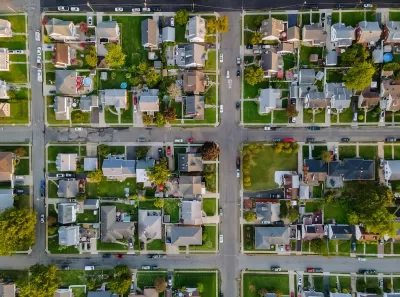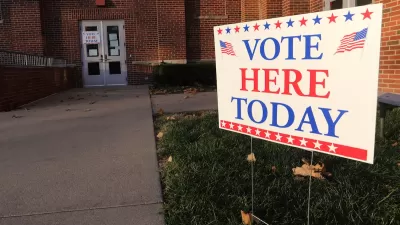The most-read articles on Planetizen in 2024.

It’s the time of year for reflection and looking back, including us here at Planetizen. This year, our readers were most interested in stories that offered analyses and solutions to the housing crisis, commentaries on the election and its possible impacts on planning issues including transportation and housing, and the growing threat of climate-induced disasters.
While a degree of virality—exponential growth of traffic due to the cascading effects of sharing on social media and elsewhere on the internet—is a common component among most of these popular posts, their popularity points to the issues that are at the top of planners’ minds.
Exclusive Articles
- The City of Broken Sidewalks (December 2024)
- To Build More Housing, Cities Must Be Smarter in How They Use Land (December 2024)
- Not a Walk in the Park: What It Really Takes to Build Green Spaces (October 2024)
- How Did We Get Here? Housing Policy and Planners’ Role in Shaping Regional Growth and Prosperity (November 2024)
- Commentary: New Bill Holds Key to Solving US Housing Crisis. We Just Have to Pass It. (October 2024)
- Commentary: How Can We Solve America’s Affordable Housing Crisis? CDFIs are the Key (October 2024)
- Bridging Divides: The Crucial Role of Collaboration in Highway Removal (November 2024)
- Shifts in Shopping: Transforming Malls Into Parks (December 2024)
- Opinion: “New Towns” Are the Answer to Affordable Housing Challenges (November 2024)
- The 100-Year Road to Car Dependency in the US (October 2024)
Blog Posts
- Where 2024 Presidential Candidates Stand on 12 Issues Important to Urban Planners (October 2024)
- The 15 Fastest-Growing Cities in the US (June 2024)
- Progressive Planning in Ideologically Conservative Communities (November 2024)
- Planning for True Transportation Affordability: Beyond Common Misconceptions (November 2024)
- Project 2025 and Housing Policy (August 2024)
- The News Is Not All Bad (November 2024)
- Evaluating Transportation Affordability: How Planners Can Better Respond to Demands for Lower Cost Travel (October 2024)
- Congestion Pricing: New York City’s Next Hero (January 2024)
- How Would Project 2025 Affect America’s Transportation System? (September 2024)
- How the Built Environment Affects Your Mood (October 2024)
News Posts
- Seattle Legalizes Co-Living (December 2024)
- Central Florida’s SunRail Plans Major Expansion (November 2024)
- Seattle Could End Restrictions on Co-Living (September 2024)
- Las Vegas Golf Course to Become Over 1,000 Units of Affordable Housing (November 2024)
- 20 Major US Cities Most and Least Threatened by Climate Change (January 2024)
- NYC Officials Announce Broadway Pedestrianization Project (December 2024)
- Biden Administration Moves to Protect Alaskan Refuge From Drilling (November 2024)
- Denver's New High-Rise Integrates Vertical Canyon in Architectural Design (November 2024)
- The Future of Electric Vehicles Under Trump (November 2024)
- Amtrak Expanding Service in California’s Central Valley (November 2024)
Planopedia
Planetizen has published over 100 definitions of common urban planning terms since the beginning of 2020, and the definition pages have quickly established themselves as popular resources. Where the previous posts identified the intensity of more topical interests, the posts below reflect a more lasting and ongoing interest in more foundational information about planning. These are the questions people are asking to inform their understanding of the world of planning.
- What Is Levittown? - Known as the archetypal post-war American suburb, Levittown was the first mass-produced housing development and set a standard for planned subdivisions for decades to come.
- What Is Regional Planning? - Regional planning addresses planning issues that cross local jurisdictional boundaries, like transportation or watershed protection.
- What Is Walkability? - Walkability refers to the ability to safely walk to services and amenities within a reasonable distance, usually defined as a walk of 30 minutes or less.
- What Is the Garden City Movement? - Born as a reaction to the crowded, dirty conditions in turn-of-the-century London and other industrial cities, the Garden City movement offers an idealized planned community designed to join elements of town and country.
- What Are Le Corbusier's Towers in the Park? - “Towers in the Park” is a style of high-rise housing complex defined by clusters of high-rise residential buildings surrounded by green space and aimed to provide dense, low-cost housing for urban workers while reducing congestion.
- What Is a Woonerf? - Translated as “living street,” a woonerf employs strategies like traffic calming devices and low speed limits to force drivers to slow down and safely share street space with pedestrians, cylists, and others, often without raised curbs separating cars and pedestrians.
- What Is Infill Development? - Billed as an alternative to urban sprawl, infill development encourages the development of underused or vacant land in existing urban areas to increase density and place new development near existing resources and infrastructure.
- What Is Mixed-Use Development? - Mixed-use development incorporates two or more uses into the same building, or in the same general area.
- What Is a Suburb? - Another term lacking a consensus definition in the field of planning, "suburb" is usually deployed to describe residential communities outside central urban areas.
- What Is Car-Centric Planning? - 'Car-centric planning' refers to urban planning that privileges the private automobile as a primary transportation mode, often to the exclusion of people who walk, bike, or use public transit.

Trump Administration Could Effectively End Housing Voucher Program
Federal officials are eyeing major cuts to the Section 8 program that helps millions of low-income households pay rent.

Planetizen Federal Action Tracker
A weekly monitor of how Trump’s orders and actions are impacting planners and planning in America.

The 120 Year Old Tiny Home Villages That Sheltered San Francisco’s Earthquake Refugees
More than a century ago, San Francisco mobilized to house thousands of residents displaced by the 1906 earthquake. Could their strategy offer a model for the present?

HSR Reaches Key Settlement in Northern California City
The state’s high-speed rail authority reached an agreement with Millbrae, a key city on the train’s proposed route to San Francisco.

Washington State Legislature Passes Parking Reform Bill
A bill that would limit parking requirements for new developments is headed to the governor’s desk.

Missouri Law Would Ban Protections for Housing Voucher Users
A state law seeks to overturn source-of-income discrimination bans passed by several Missouri cities.
Urban Design for Planners 1: Software Tools
This six-course series explores essential urban design concepts using open source software and equips planners with the tools they need to participate fully in the urban design process.
Planning for Universal Design
Learn the tools for implementing Universal Design in planning regulations.
Ada County Highway District
Clanton & Associates, Inc.
Jessamine County Fiscal Court
Institute for Housing and Urban Development Studies (IHS)
City of Grandview
Harvard GSD Executive Education
Toledo-Lucas County Plan Commissions
Salt Lake City
NYU Wagner Graduate School of Public Service





























